
Circumcision knives
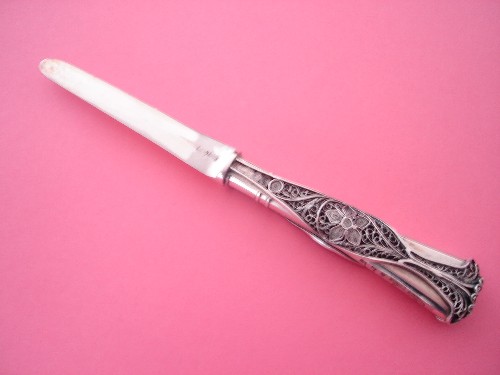
 This
silver filigree knife was my first purchase. It was
listed as Russian, circa 1900. The blade is stamped "84"
and "AC." The handle is inscribed with three Hebrew
letters: zayin,
dalet, and shin. The seller
was from Poland.
This
silver filigree knife was my first purchase. It was
listed as Russian, circa 1900. The blade is stamped "84"
and "AC." The handle is inscribed with three Hebrew
letters: zayin,
dalet, and shin. The seller
was from Poland.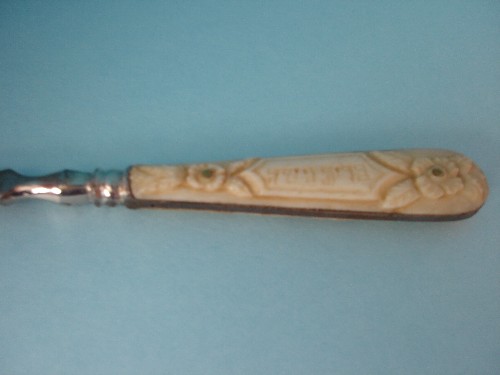
 This knife on the right has an ivory handle.
It was listed as a "very old circumcision knife." The
blade is steel. The handle has a Hebrew inscription
that is hard to read. I think it spells brit milah. The
seller was from Poland.
This knife on the right has an ivory handle.
It was listed as a "very old circumcision knife." The
blade is steel. The handle has a Hebrew inscription
that is hard to read. I think it spells brit milah. The
seller was from Poland.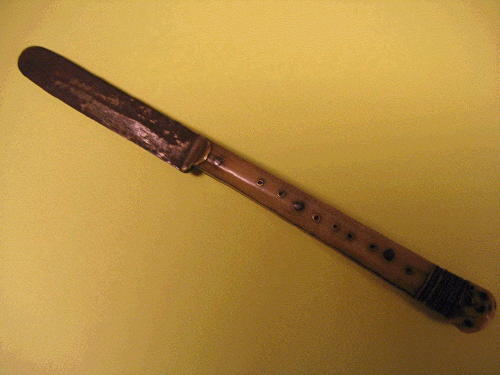 This knife has some similarities to the last
one. Its handle is also ivory. The blade is
iron and brass. The seller listed the knife as
Polish, either 18th or 19th century.
This knife has some similarities to the last
one. Its handle is also ivory. The blade is
iron and brass. The seller listed the knife as
Polish, either 18th or 19th century.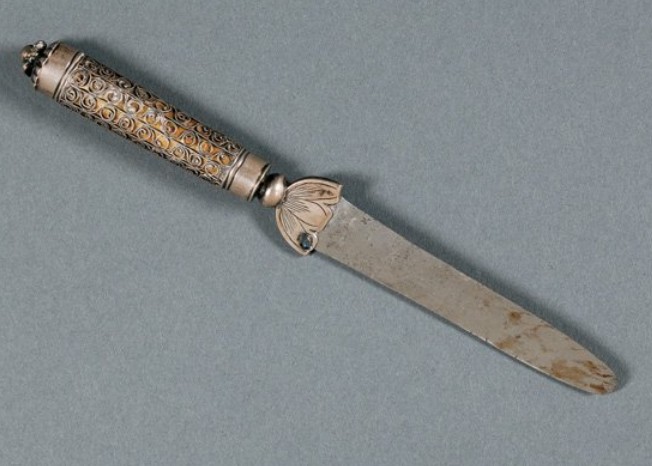 This is a stunning Polish
silver circumcision knife. The markings are early
19th century. The silver-gilt cylindrical handle
is adorned with filigree. There is a foliate
finial.
This is a stunning Polish
silver circumcision knife. The markings are early
19th century. The silver-gilt cylindrical handle
is adorned with filigree. There is a foliate
finial.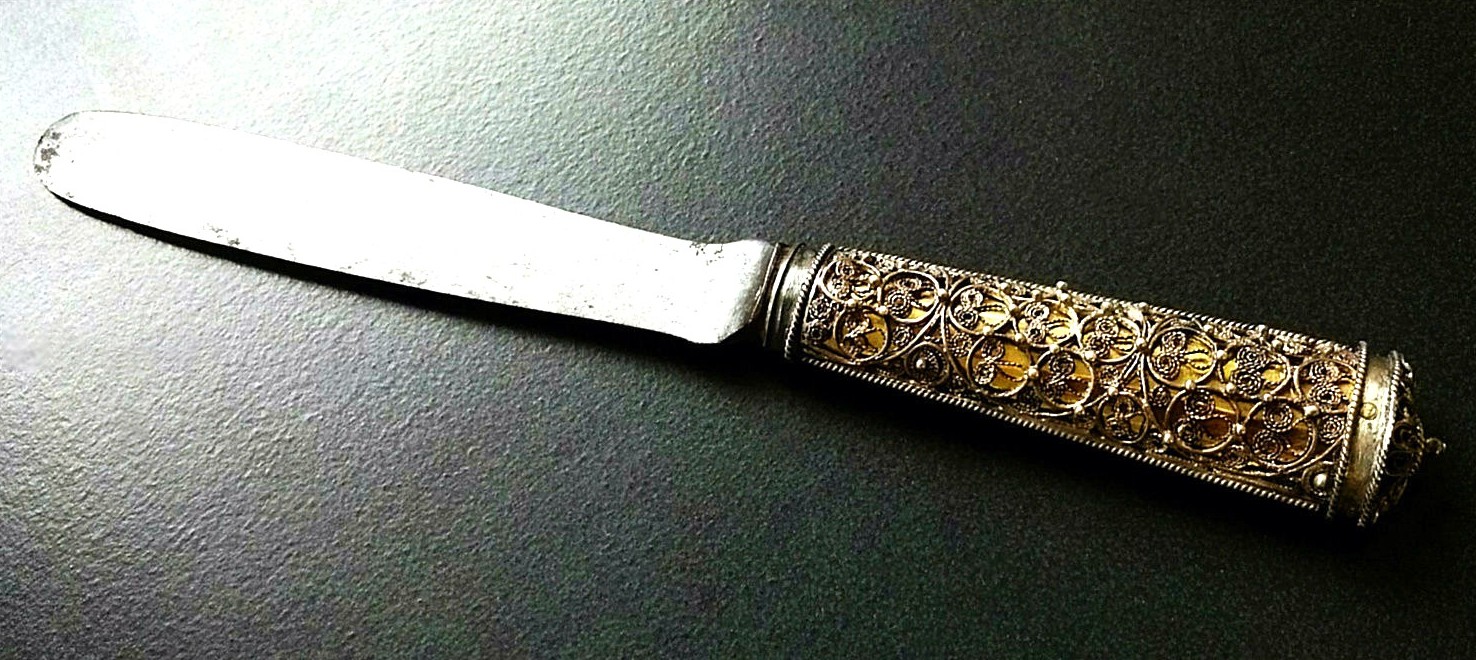 The circumcision
knife on the left, sold by a Scandinavian antiques dealer,
shares some traits with the knife above. The
close-up photo below it highlights the beautiful gilding
and filigree work. The knife is likely Swedish, from
the 17th or 18th century.
The circumcision
knife on the left, sold by a Scandinavian antiques dealer,
shares some traits with the knife above. The
close-up photo below it highlights the beautiful gilding
and filigree work. The knife is likely Swedish, from
the 17th or 18th century. 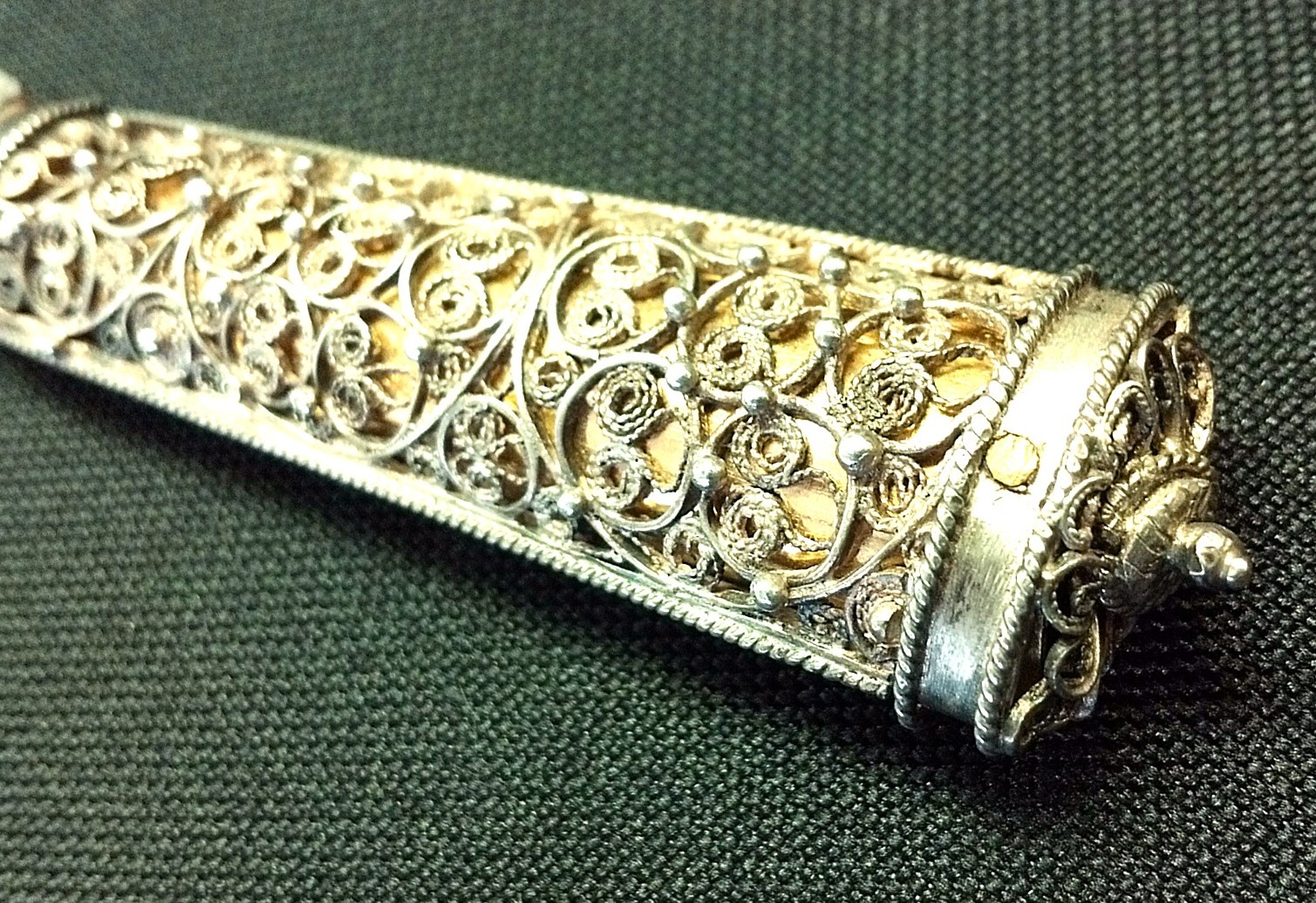
 To the right is yet another exquisite
knife with a filigree handle. The knife is likely
Polish and from the early 18th century.
To the right is yet another exquisite
knife with a filigree handle. The knife is likely
Polish and from the early 18th century.Although the other knives on this page have double-sided blades, this knife's blade is sharpened on just one side. The agate handle makes this knife a bit heavier than the others.
A Brooklyn auction house listed the knife below as a "very old circumcision knife, most likely Sephardic in origin." I was told the handle is gilded silver. On two sides of the handle are Hebrew inscriptions which are too worn to read. On the other two sides are floral decorations.
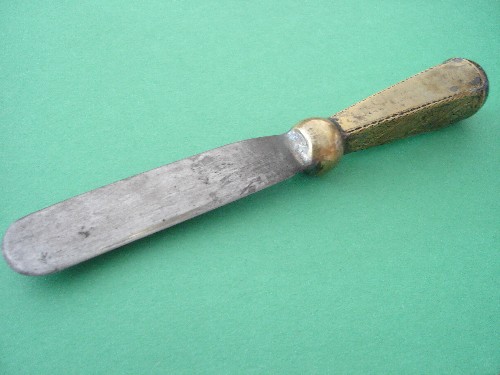
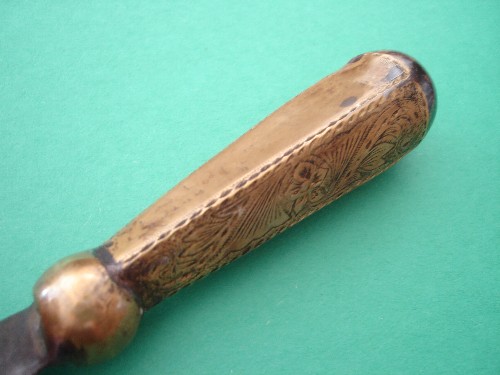
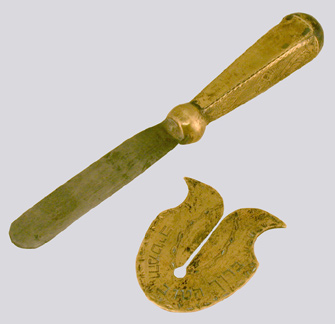 I
discovered that a different auction house sold what
appears to be the exact same knife (along with a shield)
six months prior. In that listing, the knife was
described as brass, Eastern European, mid-19th
century. Interesting!
I
discovered that a different auction house sold what
appears to be the exact same knife (along with a shield)
six months prior. In that listing, the knife was
described as brass, Eastern European, mid-19th
century. Interesting!
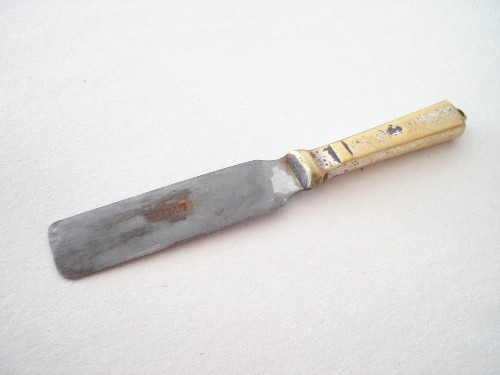 The
knife on the right was listed as a "1950 miniature mohel
knife from a well-known factory in Israel." The
original silver plating has worn off the handle.
The handle has a manufacturer's mark. The blade is
marked "stainless."
The
knife on the right was listed as a "1950 miniature mohel
knife from a well-known factory in Israel." The
original silver plating has worn off the handle.
The handle has a manufacturer's mark. The blade is
marked "stainless." To the left is a
circa 1890 circumcision knife. Its handle is
mother-of-pearl. The knife is marked on the
handle: H. PAPE/*ACHFL. It has a fitted
case.
To the left is a
circa 1890 circumcision knife. Its handle is
mother-of-pearl. The knife is marked on the
handle: H. PAPE/*ACHFL. It has a fitted
case. Addendum: A kind person wrote to me about her shochet (butcher) knife marked with the same inscription. A little research revealed that this knife is from H. Pape Nachfl., a company that was located in Memel, East Prussia (now Klaipeda, Lithuania).
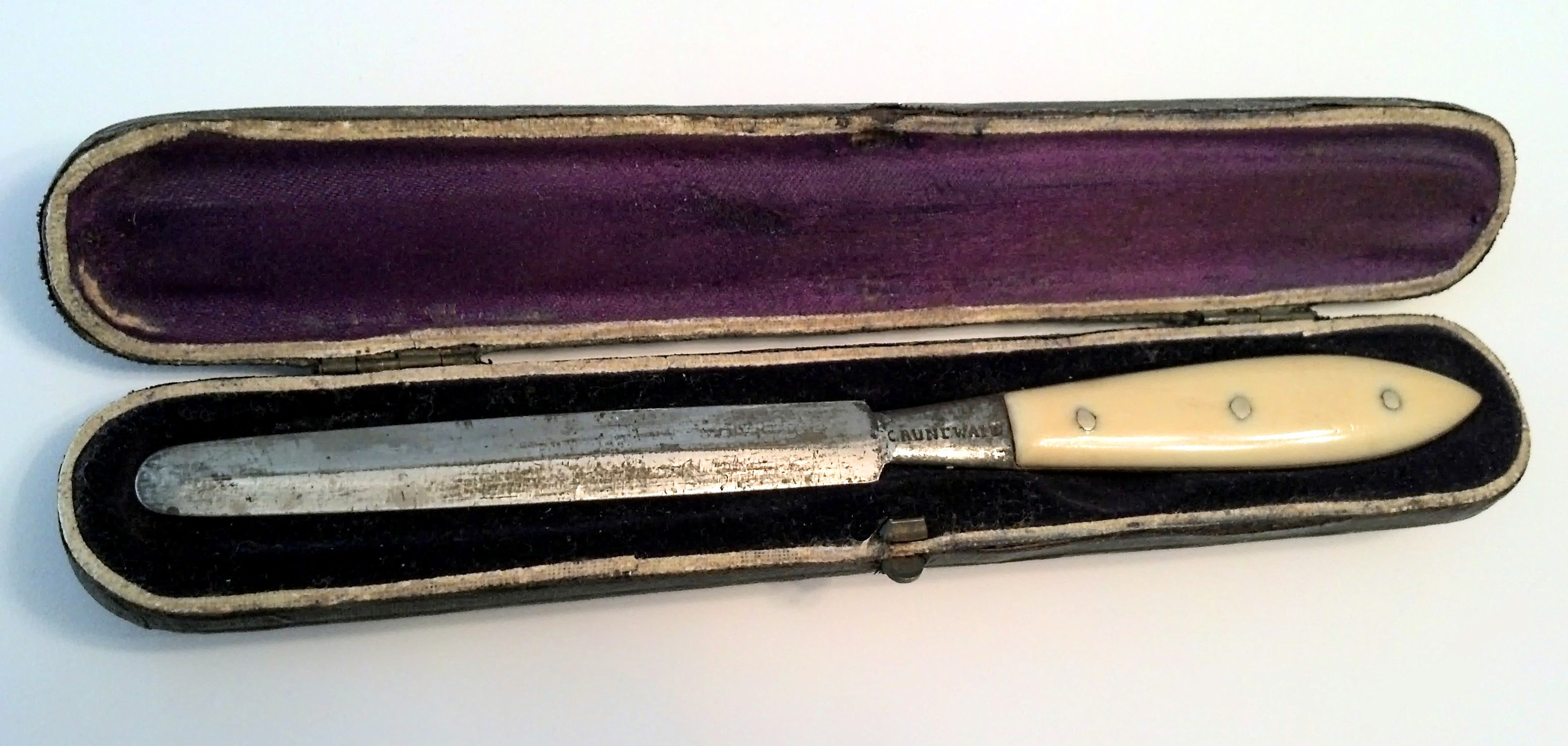 To the right is a knife from Grunewald,
likely from the late 1800s. It has a steel blade
and an ivory handle. There isn't much information
available regarding Grunewald. If anyone has a
reference for this company, please contact me.
To the right is a knife from Grunewald,
likely from the late 1800s. It has a steel blade
and an ivory handle. There isn't much information
available regarding Grunewald. If anyone has a
reference for this company, please contact me.Underneath and to the left are two similar knives from other collections. The first is another knife from Grunewald and shows the knife blade prior to repeated use and sharpening. This knife is pictured on the Phisick website. Phisick is a wonderful collection of medical antiques. The second knife is from J. & D. Miller in New York.
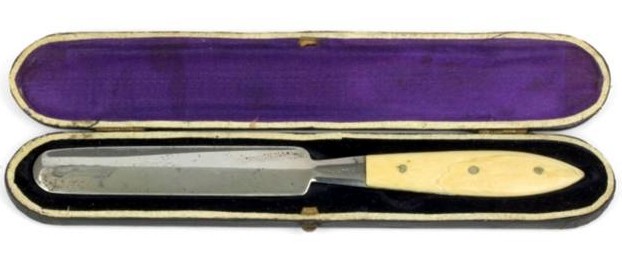

The 1920s sign below is at the National Museum of American History (Smithsonian, Washington, DC). Joseph and David Miller displayed the sign in their knife shop at 25 Canal Street, New York City. The circumcision knife and shield are at the top left. The other knives are for poultry and cattle slaughter.
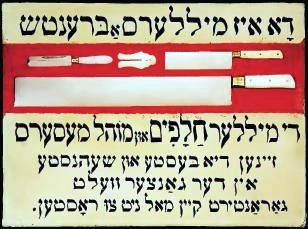
Here's a lesson: because the knife below resembles a circumcision knife, a Swedish antiques dealer contacted me.
Intrigued, I purchased the knife from him. Once I received the knife, I noticed a few things that seemed out of place--the embossing on the blade and the rounded corners of the blade where it meets the handle. These are not typical of circumcision knives.
I posted a photo on a knife discussion forum and quickly received an answer from knife expert Bernard Levine.
This is a Swedish paper knife, used in the 1800s and early 1900s to fold letters and cut open the pages of new books. It is a substantial knife, 7-3/4 inches long, with a nice ivory handle. The embossing, worn with age, is a nice, intricate design.
I'll sell it if someone is interested. Please contact me at CircCentral at yahoo dot com.
Copyright 2006-2014, Robert Lehrer, MD